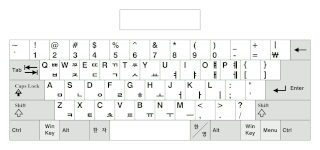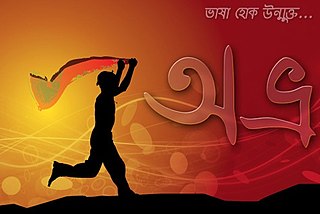
Devanagari is an Indic script used in the northern Indian subcontinent. Also simply called Nāgari, it is a left-to-right abugida, based on the ancient Brāhmi script. It is one of the official scripts of the Republic of India and Nepal. It was developed and in regular use by the 7th century CE and achieved its modern form by 1000 CE. The Devanāgari script, composed of 48 primary characters, including 14 vowels and 34 consonants, is the fourth most widely adopted writing system in the world, being used for over 120 languages.
Devanagari is an Indic script used for many Indo-Aryan languages of North India and Nepal, including Hindi, Marathi and Nepali, which was the script used to write Classical Sanskrit. There are several somewhat similar methods of transliteration from Devanagari to the Roman script, including the influential and lossless IAST notation. Romanised Devanagari is also called Romanagari.
The National Library at Kolkata romanisation is a widely used transliteration scheme in dictionaries and grammars of Indic languages. This transliteration scheme is also known as (American) Library of Congress and is nearly identical to one of the possible ISO 15919 variants. The scheme is an extension of the IAST scheme that is used for transliteration of Sanskrit.

An input method is an operating system component or program that enables users to generate characters not natively available on their input devices by using sequences of characters that are available to them. Using an input method is usually necessary for languages that have more graphemes than there are keys on the keyboard.
The International Alphabet of Sanskrit Transliteration (IAST) is a transliteration scheme that allows the lossless romanisation of Indic scripts as employed by Sanskrit and related Indic languages. It is based on a scheme that emerged during the 19th century from suggestions by Charles Trevelyan, William Jones, Monier Monier-Williams and other scholars, and formalised by the Transliteration Committee of the Geneva Oriental Congress, in September 1894. IAST makes it possible for the reader to read the Indic text unambiguously, exactly as if it were in the original Indic script. It is this faithfulness to the original scripts that accounts for its continuing popularity amongst scholars.
ISO 15919 is one of a series of international standards for romanization by the International Organization for Standardization. It was published in 2001 and uses diacritics to map the much larger set of consonants and vowels in Brahmic and Nastaliq scripts to the Latin script.
The "Indian languages TRANSliteration" (ITRANS) is an ASCII transliteration scheme for Indic scripts, particularly for the Devanagari script.
InScript is the decreed standard keyboard layout for Indian scripts using a standard 104- or 105-key layout. This keyboard layout was standardised by the Government of India for inputting text in languages of India written in Brahmic scripts, as well as the Santali language, written in the non-Brahmic Ol Chiki script. It was developed by the Indian Government and supported by several public and private organisations. This is the standard keyboard for 12 Indian scripts including Devanagari, Bengali, Gujarati, Gurmukhi, Kannada, Malayalam, Odia, Tamil and Telugu, among others. The InScript layout is built into most of the major operating systems including Windows, and most Linux and Mac OS systems. It is also available in some mobile phones and in Apple's iOS 5 and higher. It is available in Android 4.0 and higher but removed from latest Google Keyboard application (Gboard) and Google Indic Keyboard. It is also available for Windows Mobile 5.x and 6.x from third parties.
Sinhala language software for computers have been present since the late 1980s but no standard character representation system was put in place which resulted in proprietary character representation systems and fonts. In the wake of this CINTEC introduced Sinhala within the UNICODE standard. ICTA concluded the work started by CINTEC for approving and standardizing Sinhala Unicode in Sri Lanka.

Avro Keyboard is a free and open source graphical keyboard software developed by OmicronLab for the Microsoft Windows, Linux, MacOS, and several other software additionally adapted its phonetic layout for Android and iOS operating system. It is the first free Unicode and ANSI compliant Bengali keyboard interface for Windows that was published on 26 March 2003.

Google IME, also known as Google Input Tools, is a set of input method editors by Google for 22 languages, including Amharic, Arabic, Bengali, Chinese, Greek, Gujarati, Hindi, Japanese, Kannada, Malayalam, Marathi, Nepali, Persian, Punjabi, Russian, Sanskrit, Serbian, Tamil, Telugu, Tigrinya, and Urdu. It is a virtual keyboard that allows users to type in their local language text directly in any application without the hassle of copying and pasting.
Microsoft Indic Language Input Tool is a typing tool for languages written in Indic scripts. It is a virtual keyboard which allows to type Indic text directly in any application without the hassle of copying and pasting. It is available for both, online and offline use. It was released in December 2009.
The Indian blogosphere is the online predominantly community of Indian weblogs that is part of the larger blogosphere.
Bengali input methods refer to different systems developed to type the characters of the Bengali script for Bengali language and others, using a typewriter or a computer keyboard.
Clip fonts or split fonts are non-Unicode fonts that assign glyphs of Brahmic scripts, such as Devanagari, at code positions intended for glyphs of the Latin script or to produce glyphs not found in Unicode by using its Private Use Area (PUA).

Azhagi is a freeware transliteration tool, which enables its users to type in a number of regional Indian languages, including Tamil, Hindi, and others, using an English keyboard. In 2002, The Hindu dubbed Azhagi as a tool that "stand[s] out" among various similar software "emerg[ing] nearly every other day". Since year 2000, Azhagi has provided support for Tamil transliteration; this was later expanded to nearly 13 Indian languages, featuring 16 total built-in languages as of the day of writing.
The Panini Keypad is a typing technology which has been developed by Luna Ergonomics, a subsidiary of Noida. It is an application that offers single key press input in Indian language on mobile. So far, it supports Hindi, Bengali, Assamese, Telugu, Marathi, Tamil, Gujarati, Kannada, Malayalam and Punjabi.

The Tamil keyboard is used in computers and mobile devices to input text in the Tamil script.
Indic OCR refers to the process of converting text images written in Indic scripts into e-text using Optical character recognition (OCR) techniques. Broadly, it can also refer to the OCR systems of Brahmic scripts for languages of South Asia and Southeast Asia, not just the scripts of the Indian subcontinent, which are all written in an abugida-based writing system.

Meitei input methods are the methods that allow users of computers to input texts in the Meitei script, systematically for Meitei language.







